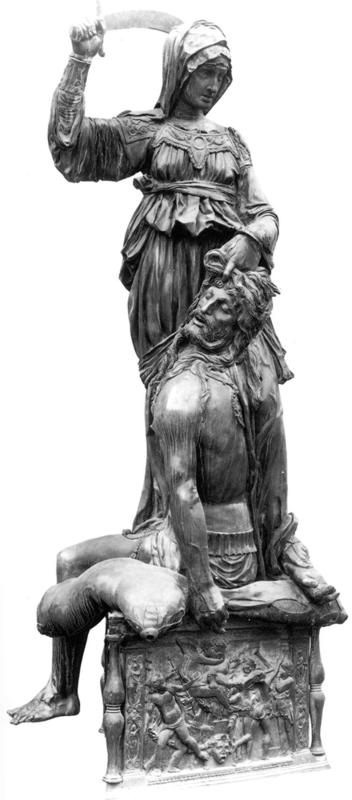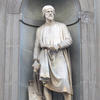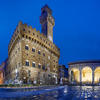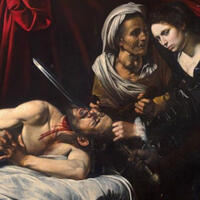More about Judith and Holofernes
- All
- Info
- Shop

Sr. Contributor
May the odds be ever in your... Oh, never mind. She has this under control.
Judith was the proto-Katniss Everdeen. In the Old Testament Book of Judith, the eponymous Judith and her people face harsh times. There's a famine. An invading army of bad mother-shut-yo-mouth Assyrians, lead by General Holofernes, is besieging the Jewish town of Bethulia. A town at a mountain pass that, if conquered, will lead to the fall of Israel. The Jews are outnumbered. They're out of water. The town leaders have said that God needs to save them in a couple days or they're just going to surrender. Judith gets tired of all the "woe is me" crap. She shows Holofernes some leg (she was apparently quite the looker), got him drunk off her lady humps (and, true story, kept him thirsty by feeding him salted cheese), and then cut his damn head off. No Assyrians, no problem. Life went on and nothing bad ever happened again, anywhere, to anyone.
This is the only work Donatello signed his name to. He picked a good one, since this became one of his most famous and groundbreaking works. First of all, there's a lot of depictions of Judith offing Holofernes. One is even the unassuming label of a porcini and tomato pasta sauce (let this be a lesson learned for why the world needs art historians). Donatello's is the only version executed as a monument. It's one of the earliest freestanding statues from the Renaissance, also one of the first intended to be viewed from every angle. Though, unlike almost every other famous statue in the round, you don't get any good butt views.
Despite the fact that Judith supposedly just made an indecent proposal, she's obviously got a conservative look going on. Holofernes, however, looks like he's been losing for hours at strip poker and beer pong simultaneously. But she didn't strip him down for the decapitation, he did that to himself. Between his nudity, drunkenness (which Donatello just nails), and the pillow, Holofernes seems like quite the lush. It's kind of hard to feel bad for the guy.
Cosimo de Medici contracted Donatello for this project. Cosimo wanted the statue to go with Donatello's equally-famous, hyper-nudey statue of David in the Medici palace garden. After the Medicis were exiled from Florence, the Republic moved the statue to a public venue and got rid of the inscriptions: "Kingdoms fall through luxury, cities rise through virtues. Behold the neck of pride severed by the hand of humility." The new populist government replaced Medici's poetic line with something a little more to the point: "An exemplar of the public good. The citizens installed it here in 1495." They could have just gone with, "Suck it Medici!"

Featured Books & Academic Sources
The following is an excerpt from "Lives of the Most Eminent Painters, Sculptors and Architects. Vol. 2, Berna to Michelozzo Michelozzi" by Georgio Vasari, originally published in 1550:
For the Signoria of [Florence] he made a casting in metal which was placed under an arch of their Loggia in the Piazza, representing Judith cutting off the head of Holofernes; a work of great excellence and mastery, which, if one considers the simplicity of the garments and aspect of Judith on the surface, reveals very clearly below the surface the great spirit of that woman and the assistance given to her by God, even as one sees the effect of wine and sleep in the expression of Holofernes, and death in his limbs, which have lost all life and are shown cold and limp. This work was so well executed by Donato that the casting came out delicate and very beautiful, and it was afterwards finished so excellently that it is a very great marvel to behold. The base, likewise, which is a baluster of granite, simple in design, appears full of grace and presents an aspect pleasing to the eye. He was so well satisfied with this work that he deigned to place his name on it, which he had not done on the others; and it is seen in these words, "Donatelli opus."
Sources
- Vasari, Giorgio. "Lives of the Most Eminent Painters Sculptors and Architects Vol 2, Berna to Michelozzo Michelozzi" (London: PHILIP LEE WARNER, PUBLISHER TO THE MEDICI SOCIETY, LIMITED). 244-245.
Featured Content
Here is what Wikipedia says about Judith and Holofernes (Donatello)
Judith and Holofernes (1457–1464) is a bronze sculpture by the Italian Renaissance sculptor Donatello at the end of his career. It is located in the Hall of Lilies (Sala dei Gigli), in the Palazzo Vecchio, Florence, Italy. A copy stands in one of the sculpture's original positions on the Piazza della Signoria, in front of the Palazzo Vecchio.
It depicts the assassination of the Assyrian general Holofernes by Judith and is remarkable for being one of the first Renaissance sculptures to be conceived in the round, with its four distinct faces. The subject of Judith beheading Holofernes, depicting the climax of the story in the deuterocanonical Book of Judith, was a common subject in art and is associated with the Power of Women topos.
Check out the full Wikipedia article about Judith and Holofernes (Donatello)















